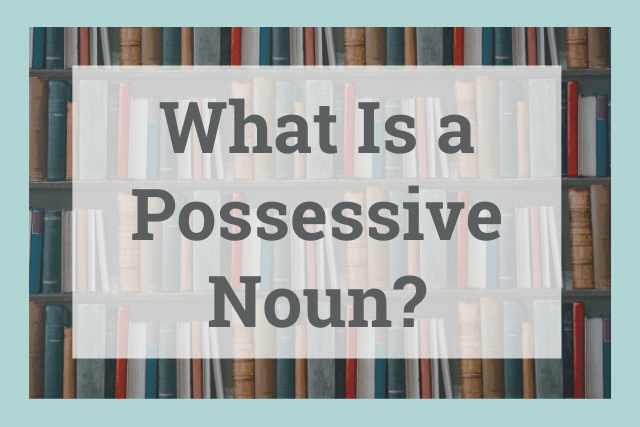
You probably know that a noun is a person, place, or thing. But when a noun has possession of another noun, things can get a little tricky. We typically use apostrophes to show possession. However, it’s easy to get confused about where to put those apostrophes.
Today, we’re doing a deep dive into possessive nouns. We’ll cover exactly what they are and how to write them correctly.
What Are Possessive Nouns?
A possessive noun is a noun that possesses (owns or has power over) something else. Before you start worrying about nouns possessing you like an angry ghost or jealous boyfriend, let me clarify what we mean by possessive.
In this case, possessive nouns show ownership or belonging.
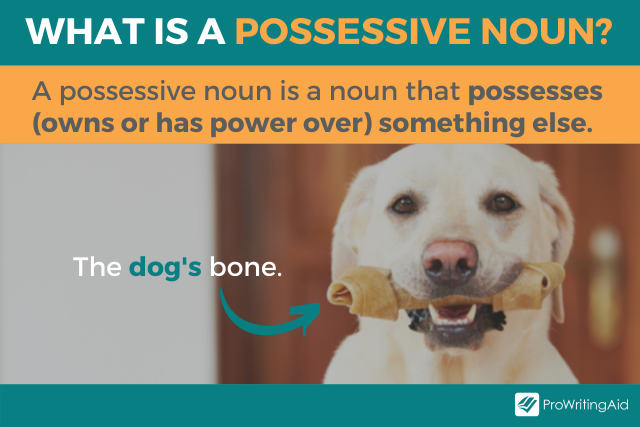
In other words, if a noun has something that belongs to it, we need to turn that noun into its possessive form.
Take a look at the following examples. The bolded nouns are the possessive one.
- the dog’s bone
- the baby’s pacifier
- the students’ exams
- Juan’s mom
- The Smiths’ vacation home
The bone belongs to the dog, the pacifier belongs to the baby, and so on. The noun to which the object belongs is the one we write in the possessive form.
How Do I Write a Possessive Noun in the Singular Form?
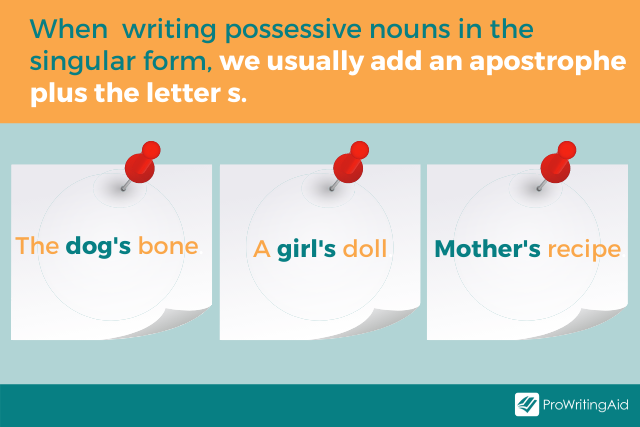
When it comes to a singular noun (i.e. only one person, place, or thing), we usually add an apostrophe plus the letter /s/. The apostrophe follows the singular form of the noun, and the /s/ follows the apostrophe.
Most singular nouns do not end in an /s/ so it feels natural to add the apostrophe plus /s/ at the end of the word. Here are some examples:
- the hen’s egg
- a rat’s tail
- my mom’s recipe
But even if a singular noun ends in an /s/, we still add an apostrophe plus another /s/. It might look or sound strange to have the extra /s/, but this is often the grammatically correct way to write singular possessive nouns.
What does this look like? Check out these examples of singular possessive nouns.
- the bus’s radiator
- the iris’s petals
- an octopus’s tentacle
The same rule applies to singular possessive proper nouns. A proper noun is a noun that has to be capitalized, like a person’s name or a specific place. It doesn’t matter if the proper noun ends in an /s/ or not. If you are only talking about one proper noun, add an apostrophe followed by an /s/.
These examples show you how to write singular proper nouns in the possessive form.
- Michelle’s book
- Mr. James’s class
- Hawaii’s capital
- Dallas’s mayor
The rule never changes for singular possessive nouns, but things can get trickier with plural nouns.
How Do I Write a Possessive Noun in the Plural Form?

Plural possessive nouns follow two different rules. It depends on how the word is written in the possessive form.
When a noun is made plural by adding an /s/, like most nouns in English, we write the possessive form by adding the /s/ and then an apostrophe. Nothing comes after the apostrophe in plural possessive nouns.
It looks like this:
- my kids’ toys
- the neighbors’ yard
- the homes’ occupants
But some nouns do not end in an /s/ when they are plural. When this is the case, follow the same format as singular possessive nouns. You will add an apostrophe plus an /s/. Here are a few examples.
- the children’s teacher
- the geese’s nest
- people’s rights
With proper nouns, we make them plural by adding an /s/ or, in the case of proper nouns that already end in /s/, we add an /es/. To make them possessive, add an apostrophe after the last /s/.
- the Joneses’ new dog
- the Dunns’ anniversary
- the Obamas’ organization
Only add an apostrophe to proper nouns if you are using the plural possessive noun to indicate that the noun possesses something.
If you are just making a proper noun plural, no apostrophe is needed. Don’t sign your Christmas cards using an apostrophe in your family’s last name, or you’ll leave people wondering, “The Blacks’ what?”
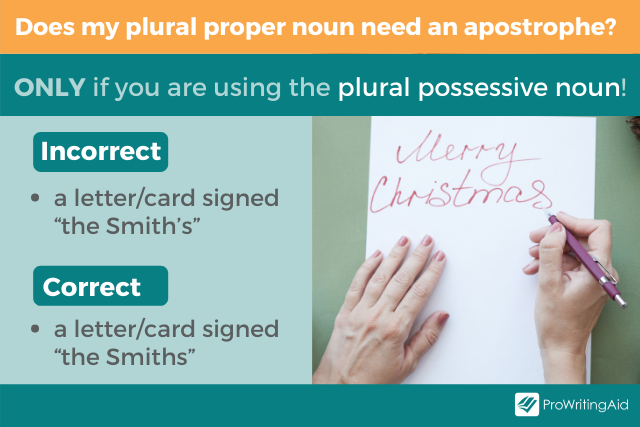
So, when you’re writing a plural possessive noun, ask yourself if the plural form already ends in an /s/. If so, just add the apostrophe at the end of the plural form. If not, treat it like a singular possessive noun and add an apostrophe plus /s/.
It’s easy to slip up and put the apostrophe in the wrong place. ProWritingAid’s grammar report will make sure that you are writing your possessive nouns correctly.
What Are Some Examples of Possessive Nouns in a Sentence?
We’ve looked at a few examples of possessive nouns, but you might be wondering how these are used in sentences. Let’s take a look at some sentences that use possessive nouns.
- I went over to my aunt’s house for dinner last night.
- We played with my cousins’ new Playstation.
- He helped pass the two junior senators’ bill.
- The monkey’s baby was so tiny!
- Have you seen Uncle Jerry’s new motorcycle?
- The Martinezes’ anniversary is tomorrow.
Once you’ve mastered the three rules for writing possessive nouns, you’ll have no trouble remembering where to put the apostrophe. But what about pronouns?
What Is a Possessive Pronoun?
Pronouns are words that replace more specific nouns. I, he, she, and it are all pronouns.
Possesive pronouns indicate ownership. They are words like mine, his, hers and its. Here's an example:
That was the dog's ball. It was his to play with.
See how "his" replaces "the dog's" in the second sentence? Possessive pronouns are words that show possession while replacing other nouns or proper nouns.
Possessive pronouns follow their own set of rules, and they don’t use any apostrophes. There are thirteen possessive pronouns.

What Are the 13 Possessive Pronouns?
There are two types of possessive pronouns.
- Independent possessive pronouns do not have a noun immediately following them. They are sometimes called strong possessive pronouns.
- Dependent possessive pronouns go before the noun and help to identify it in further detail. They are sometimes called weak possessive pronouns or possessive adjectives.
The independent singular possessive pronouns are mine, yours, his, hers, and its. The independent plural possessive pronouns are ours, yours, and theirs. Notice that yours is both singular and plural. Its is very rarely used as an independent possessive pronoun in modern English.
Dependent possessive pronouns function as determiners before another noun.
The dependent singular possessive pronouns are my, your, his, her, and its. The dependent plural possessive pronouns are our, your, and their. You’ll notice that your is used for both singular and plural forms, and that his is both independent and dependent.
When it comes to its vs. it’s, the possessive pronoun never uses an apostrophe. If the word is showing possession, use its. If the word is a contraction of “it is,” use it’s.
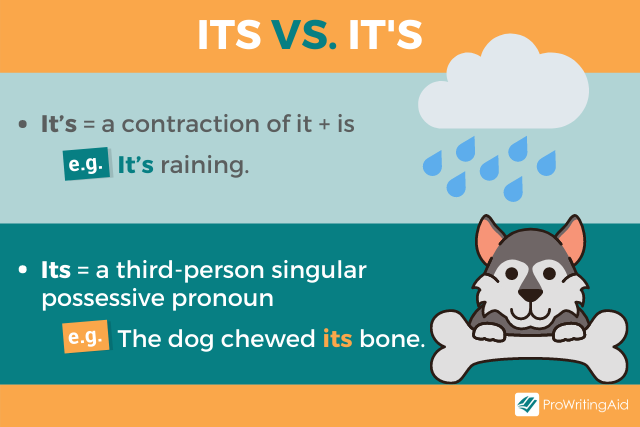
Now that we know the different types of possessive pronouns, let’s look at some examples.
What Are Some Examples of Possessive Pronouns in a Sentence?
Take a look at the sentences below. Can you identify which sentences use independent and dependent possessive pronouns? What about singular and plural possessive pronouns?
- The ball is mine.
- Give me back my sweater!
- I can’t believe that is your name on the marquee!
- I told her the money is yours, not hers.
- His grandmother makes the best lasagne.
- The red coat? It was his.
- It’s time for her appointment.
- Oops. I cracked its shell.
- We reminded him that the seats were ours.
- I think the car is theirs.
- Their dog is a basset hound.
Can You Use Possessive Nouns?
Possessive nouns and pronouns can be tricky until you learn the rules. Fortunately, with a bit of practice, you can get them right, every time. And if you don’t remember all the rules, that’s fine too. ProWritingAid’s Realtime Report is always there to help if you get it wrong.
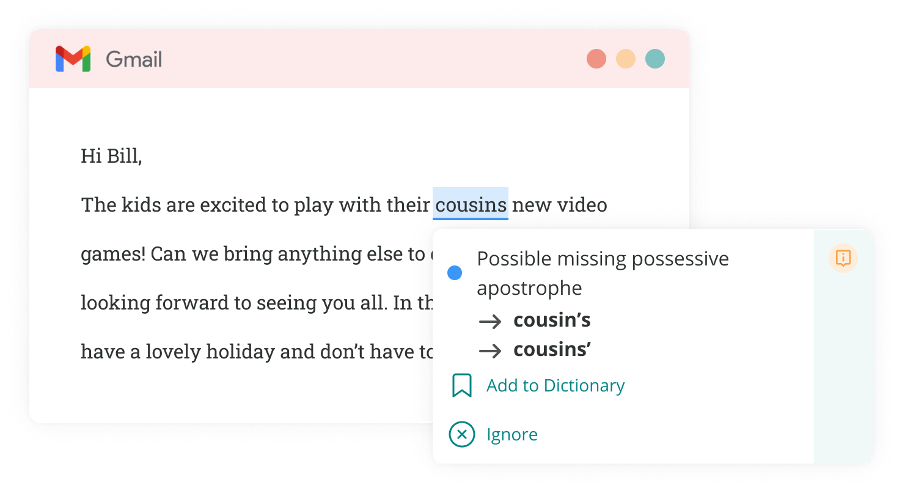
Try the Realtime Report with a free ProWritingAid account.


